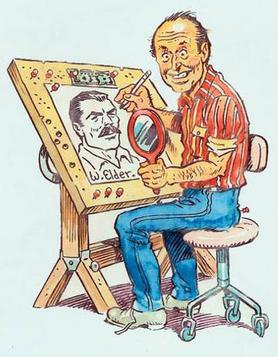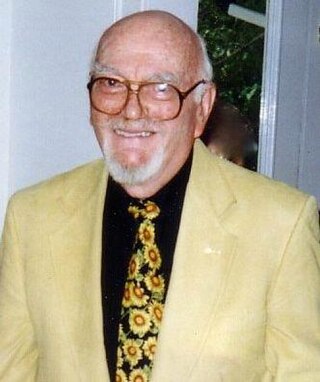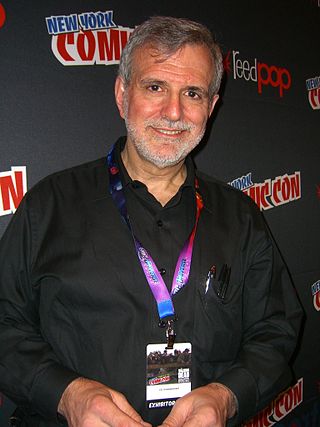
A cartoon is a type of visual art that is typically drawn, frequently animated, in an unrealistic or semi-realistic style. The specific meaning has evolved over time, but the modern usage usually refers to either: an image or series of images intended for satire, caricature, or humor; or a motion picture that relies on a sequence of illustrations for its animation. Someone who creates cartoons in the first sense is called a cartoonist, and in the second sense they are usually called an animator.

Mad is an American humor magazine first published in 1952. It was founded by editor Harvey Kurtzman and publisher William Gaines, launched as a comic book series before it became a magazine. It was widely imitated and influential, affecting satirical media, as well as the cultural landscape of the 20th century, with editor Al Feldstein increasing readership to more than two million during its 1973–74 circulation peak.

Dave Berg was an American cartoonist, most noted for his five decades of work in Mad of which The Lighter Side of... was the most famous.

Morris "Mort" Drucker was an American caricaturist and comics artist best known as a contributor for over five decades in Mad, where he specialized in satires on the leading feature films and television series.

Crazy Magazine is an illustrated satire and humor magazine that was published by Marvel Comics from 1973 to 1983 for a total of 94 regular issues. It was preceded by two standard-format comic books titled Crazy. The magazine's format followed in the tradition of Mad, Sick, Cracked and National Lampoon.

Harvey Kurtzman was an American cartoonist and editor. His best-known work includes writing and editing the parodic comic book Mad from 1952 until 1956, and writing the Little Annie Fanny strips in Playboy from 1962 until 1988. His work is noted for its satire and parody of popular culture, social critique, and attention to detail. Kurtzman's working method has been likened to that of an auteur, and he expected those who illustrated his stories to follow his layouts strictly.

The Mad Fold-In is a feature found on the inside back cover of virtually every Mad magazine since 1964. Written and drawn by Al Jaffee until 2020, the Fold-In is one of the most well-known aspects of the magazine. The feature was conceived in response to centerfolds in popular magazines, particularly Playboy.
Spy vs. Spy is a wordless comic strip published in Mad magazine. It features two agents involved in stereotypical and comical espionage activities. One is dressed in white, and the other in black, but they are otherwise identical, and are particularly known for their long, beaklike heads and their white pupils and black sclera. The pair are always at war with each other, using a variety of booby traps to inflict harm on the other. The spies usually alternate between victory and defeat with each new strip. A parody of the political ideologies of the Cold War, the strip was created by Cuban expatriate cartoonist Antonio Prohías, and debuted in Mad #60, dated January 1961. Spy vs. Spy is currently written and drawn by Peter Kuper.
Antonio Prohías was a Cuban-American cartoonist. He was the creator of the satirical comic strip Spy vs. Spy, which he illustrated for Mad magazine from 1961 to 1987.

William Elder was an American illustrator and comic book artist who worked in numerous areas of commercial art but is best known for a frantically funny cartoon style that helped launch Harvey Kurtzman's Mad comic book in 1952.

Little Annie Fanny is a comics series by Harvey Kurtzman and Will Elder. It appeared in 107 two- to seven-page episodes in Playboy magazine from October 1962 to September 1988. Little Annie Fanny is a humorous satire of contemporary American society and its sexual mores. Annie Fanny, the title character, is a statuesque, buxom young blonde woman who innocently finds herself nude in every episode. The series is notable for its painted, luminous color artwork and for being the first full-scale, multi-page comics feature in a major American publication.
Nick Meglin was an American writer, humorist, and artist. He was known for his work as a contributor, comics writer, illustrator and editor for the satirical magazine Mad. He also scripted Superfan, a 1970s comic strip by Jack Davis. He was active as a lyricist of musical theatre, and had columns in various specialized magazines about culture and sports.

Robert J. "Bob" Clarke was an American illustrator whose work appeared in advertisements and MAD Magazine. The label of the Cutty Sark bottle is his creation. Clarke was born in Mamaroneck, New York. He resided in Seaford, Delaware.

Tom Richmond is an American freelance humorous illustrator, cartoonist and caricaturist whose work has appeared in many national and international publications since 1990. He was chosen as the 2011 "Outstanding Cartoonist of the Year", also known as "The Reuben Award", winner by the National Cartoonists Society.

Sam Viviano is an American caricature artist and art director. Viviano’s caricatures are known for their wide jaws, which Viviano has explained is a result of his incorporation of side views as well as front views into his distortions of the human face. He has also developed a reputation for his ability to do crowd scenes. Explaining his twice-yearly covers for Institutional Investor magazine, Viviano has said that his upper limit is sixty caricatures in nine days.
Dean Rankine is an Australian comics artist, writer and illustrator. Rankine's work has appeared in many comics, books and magazines.
Mad is known for many regular and semi-regular recurring features in its pages.

Goodman Beaver is a fictional character who appears in comics created by American cartoonist Harvey Kurtzman. Goodman is a naive and optimistic Candide-like character, oblivious to the corruption and degeneration around him, and whose stories were vehicles for social satire and pop culture parody. Except for the character's first appearance, which Kurtzman did alone, the stories were written by Kurtzman and drawn by Will Elder.

American cartoonist Harvey Kurtzman was the founding editor and primary writer for the humor periodical Mad from its founding in 1952 until its 28th issue in 1956. Featuring pop-culture parodies and social satire, what began as a color comic book became a black-and-white magazine with its 24th issue.

Alfred E. Neuman is the fictitious mascot and cover boy of the American humor magazine Mad. The character's distinct smiling face, parted red hair, gap-tooth smile, freckles, protruding nose, and scrawny body, first emerged in U.S. iconography decades prior to his association with the magazine, appearing in late nineteenth-century advertisements for painless dentistry – the origin of his "What, me worry?" motto. However, he first appeared in advertisements for an 1894 play, called "The New Boy", which portrayed a variation of him with the quote, "What's the good of anything? – Nothing!". He also appeared in the early 1930s, on a presidential campaign postcard with the caption "Sure I'm for Roosevelt". The magazine's editor Harvey Kurtzman claimed the character in 1954, and he was named "Alfred E. Neuman" by Mad's second editor, Al Feldstein, in 1956. Since his debut in Mad, Neuman's likeness has appeared on the cover of all but a handful of the magazine's over 550 issues. Rarely seen in profile, Neuman has almost always been recognizable in front view, silhouette, or directly from behind.